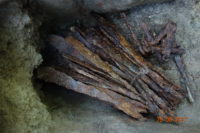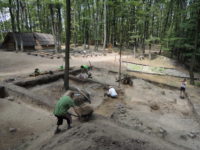 Archaeologists have discovered a hoard of 10th century iron hidden in a medieval oven in the village of Bojná, western Slovakia.
Archaeologists have discovered a hoard of 10th century iron hidden in a medieval oven in the village of Bojná, western Slovakia.
The Slavic inhabitants of the region hid it in a stone oven at the beginning of the 10th century. Iron was in that era was a very precious metal; as the metal “hrivna” it was used for currency.
“The surprising discovery consists of 36 hrivna, bridle bits from a horse harness, two keys from a Slavic settlement and other iron objects,” said head of research in Bojná Karol Pieta from the Archaeological Institute of the Slovak Academy of Sciences, as quoted by the SITA newswire.
Strategically located at the foot of the Považský Inovec mountain range where a pass through the mountains connects the Váh and Nitra river basins, the town’s history long predates the presence of the actual town. The first historical records alluding to Bojná date to the 15th century, but the area was dotted with hill forts defending the pass under the Slavic kingdom of Great Moravia (833 – ca. 906/907).
 One of those hill forts, today known as Bojná I – Valy, has been found to be a rich source of archaeological materials even predating the Great Moravian fortifications. The oldest writing in Slovakian history were found there, Latin inscriptions dating to the late 8th, early 9th century, the earliest days of Christianity in the area. It was in the 9th century when Great Moravia was at its zenith that the fortress became a hive of activity. The remains of several blacksmith shops from this period have been unearthed and their work products have been found by the thousands — farming and craftsmen’s tools, battle axes, knives, swords, seaxes, horse fittings, chain mail, spurs. Some of the weaponry and armature is gold and silver plated, evidence of the presence of a significant number of elite warriors.
One of those hill forts, today known as Bojná I – Valy, has been found to be a rich source of archaeological materials even predating the Great Moravian fortifications. The oldest writing in Slovakian history were found there, Latin inscriptions dating to the late 8th, early 9th century, the earliest days of Christianity in the area. It was in the 9th century when Great Moravia was at its zenith that the fortress became a hive of activity. The remains of several blacksmith shops from this period have been unearthed and their work products have been found by the thousands — farming and craftsmen’s tools, battle axes, knives, swords, seaxes, horse fittings, chain mail, spurs. Some of the weaponry and armature is gold and silver plated, evidence of the presence of a significant number of elite warriors.
 The fort was conquered in the early 10th century by invading Hungarians who burned it down. It was never rebuilt and the people who had lived and worked there moved on, leaving behind their cached valuables in the rubble. The stone oven containing the iron pieces was found on the west side of the Great Moravian-era fortification. They had been placed in an earthenware vessel and then stashed in the oven, a brilliant hiding place when there’s a real threat of fire and destruction looming. In fact, it was so effective that archaeologists found the vessel intact and undamaged, unmoved even. It stood in the same exact spot where some 10th century Slav left it doubtless in the hope of recovering his treasures when the carnage was over.
The fort was conquered in the early 10th century by invading Hungarians who burned it down. It was never rebuilt and the people who had lived and worked there moved on, leaving behind their cached valuables in the rubble. The stone oven containing the iron pieces was found on the west side of the Great Moravian-era fortification. They had been placed in an earthenware vessel and then stashed in the oven, a brilliant hiding place when there’s a real threat of fire and destruction looming. In fact, it was so effective that archaeologists found the vessel intact and undamaged, unmoved even. It stood in the same exact spot where some 10th century Slav left it doubtless in the hope of recovering his treasures when the carnage was over.
 Archaeologists are currently working on a reconstruction of the east gate of the Bojná I – Valy fortifications. This 9th century Great Moravian monumental gate was enormous with a tower 40 feet high and thick defensive walls to match. The hill fort already has a few modest reconstructions — three private dwellings — from its heyday, but the hope is the added drama of the reconstructed 9th century gate will draw tourism to the site. Construction is scheduled to be complete in the middle of next year.
Archaeologists are currently working on a reconstruction of the east gate of the Bojná I – Valy fortifications. This 9th century Great Moravian monumental gate was enormous with a tower 40 feet high and thick defensive walls to match. The hill fort already has a few modest reconstructions — three private dwellings — from its heyday, but the hope is the added drama of the reconstructed 9th century gate will draw tourism to the site. Construction is scheduled to be complete in the middle of next year.